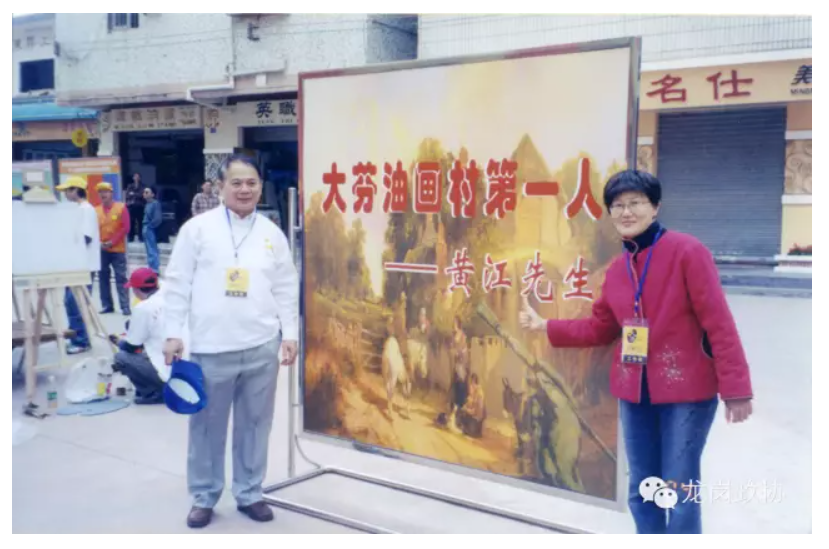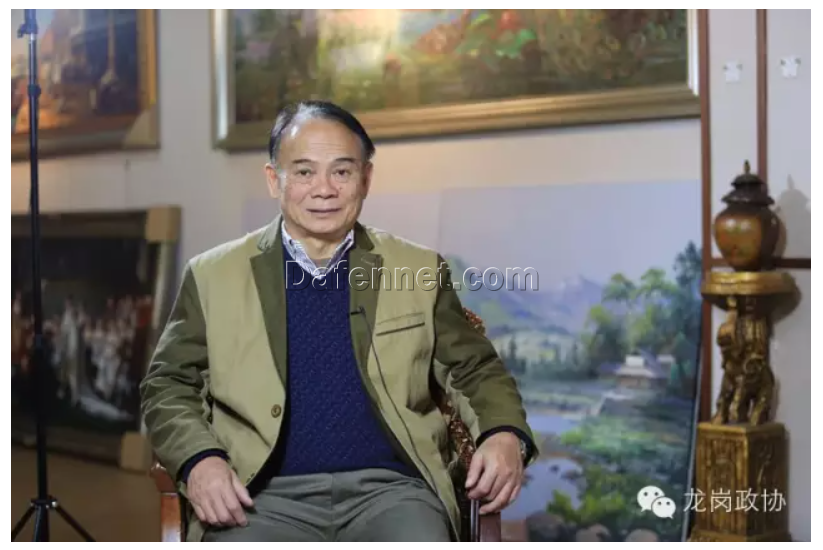Dafen oil painting Village
Dafen Oil Painting Village: The Remarkable Journey of Its Founder, Huang Jiang

Huang Jiang, originally from Sihui in Guangdong and raised in Guangzhou, laid the very first cornerstone of what would later become China’s most famous oil-painting village. In 1989, he set up the first oil-painting workshop in Dafen, a small village in Buji, Longgang. It attracted painters and art lovers from all over the country, opening the first chapter in the story of Dafen Oil Painting Village.
By 1999, with the support of the Longgang District government, the Dafen village committee, and local residents, he established Shenzhen Oil Painting Co., the Huang Jiang Art Plaza, and the Huang Jiang Oil Painting Training Center, pushing Dafen toward industrial-scale development. Today, Huang Jiang is widely recognized as the founder, pioneer, and first person of Dafen Oil Painting Village.
Love at First Sight: A Quiet Village That Became a Haven for Painters
The first time I saw Dafen, it was nothing more than a quiet, remote settlement tucked between the hills. To most people, it looked poor and backward — dusty dirt paths, reeds everywhere, old houses patched together with whatever materials villagers could find. A three-wheeled cart was considered the “luxury vehicle” of the village. A black-and-white TV meant you were doing well.
But to me, it was perfect.
I grew up in Guangzhou and later moved to Hong Kong in the 1970s. Before coming to Shenzhen, I ran a business producing “commercial paintings” — reproductions of world-famous artworks for export. Costs were far lower on the mainland, so I set up workshops in Guangzhou and Jiangmen and sold paintings to overseas markets through Hong Kong.
Shenzhen, however, had an even bigger advantage: customs procedures were easier and cheaper. By 1987 I moved here and co-founded an oil-painting workshop in Huangbeiling. But rents doubled in just over a year, and I had no choice but to look elsewhere.
Someone told me that areas outside the original Special Economic Zone were much cheaper. I visited Buji and found myself walking into Dafen — and I immediately knew it was the place.
Dafen didn’t require border permits, rents were low, the people were honest, and the village was quiet enough for painters to focus. It felt like a peaceful harbor.
So on the 14th of the eighth lunar month in 1989, I arrived with more than 20 apprentices and rented a 250-square-meter house for 1,600 yuan. That’s where the story began.
How “Commercial Painting” Sparked a Village-Wide Industry
A massive order of 360,000 paintings — due in only six weeks — forced us to invent an assembly-line painting method that spread throughout the village and shaped Dafen’s future as a global oil-painting hub.
I first landed a major deal in 1986, when Walmart posted an advertisement in Hong Kong looking for suppliers. I brought them samples, they liked the quality, and handed me a 6,000-piece order. The margin was tiny, but the volume was too tempting to refuse. I accepted, finished the order, and made a modest profit — and Walmart became my long-term client.
When I moved to Dafen in 1989, I brought my most skilled painters with me. Business grew fast. Painters from Guangzhou Academy of Fine Arts, Sichuan Academy of Fine Arts, and many others came looking for opportunities. Eventually, many of my apprentices opened their own studios. People took on orders and hired more painters. That’s how Dafen’s painting industry took shape.
The real turning point came in April 1992, when a French client placed a staggering order of 360,000 paintings to be completed in a month and a half — at a time when we could handle only about 100,000 pieces per month.
With no other choice, I gathered all 400+ painters in Dafen and created our now-famous assembly-line method: one painter specialized in mountains, another in skies, another in trees, another in details. Skill improved through repetition, and production speed skyrocketed.
When the client checked the shipment, he said the paintings looked as identical as photocopies.
From that point on, Dafen’s reputation spread worldwide. By the early 2000s, Dafen studios supplied 70% of the oil-painting market in Europe and the U.S.. With government investment, the once-remote village transformed into a lively “European-style oil-painting town.”
A New Era Begins: Dafen Meets the Cultural Industries Fair
In 2004, the first China (Shenzhen) Cultural Industries Fair chose Dafen as its only branch venue. The government invested heavily in transforming the village: new plazas, exhibition halls, galleries, artistic streetlights, Da Vinci sculptures, and colorful pavements.
That year marked Dafen’s rebirth.
The “Huang Jiang Oil Painting Art Plaza” was built at the village entrance — something I had never imagined when I first came here just wanting a place to paint.
During the fair, Dafen was awarded the title of National Cultural Industry Demonstration Base, becoming Longgang District’s first cultural-industry landmark. Sales skyrocketed:
- 2003: 80 million yuan
- 2004: 140 million yuan
- 2005: 279 million yuan
- 2006: 400 million yuan
- 2014: 4.5 billion yuan
But the global financial crisis hit hard. Orders dropped, some studios had none at all. Many painters left; others turned to new markets. I also opened galleries in Yiwu and Beijing to shift from export to domestic sales.
This period pushed Dafen to develop original art, and today it has grown into an ecosystem combining culture, technology, finance, tourism, and design. The vision is to build Dafen International Art Community, a future hub connecting global art markets.
Unforgettable Moments
A Thousand Painters Painting Together
The most unforgettable event for me was the thousand-painter live creation at the opening of the first Cultural Industries Fair. On November 18, 2004, a thousand easels lined the streets. Painters in white T-shirts recreated masterpieces, sketched from life, or improvised.
My number was specially assigned as 1000, a nod to the title “the first person of Dafen Oil Painting Village.” I painted the scene in front of me — a village alive with creativity — and named it Autumn in Dafen.
After the fair, Dafen became famous. Visitors poured in, reporters from all over the world came, and sometimes I did two or three interviews a day. I signed so many autographs my hand would go numb.
Interview Highlights
Q: What was your first impression of Longgang?
Huang Jiang: I only knew Dafen back then — a remote mountain village where people lived simple farming lives. It was quiet, isolated, and untouched.
Q: What change has impressed you the most over the past 22 years?
Huang Jiang: Roads. Transportation. Back then, Longgang’s main road was bumpy and muddy, barely wide enough for three lanes. It made business incredibly hard. Once the government invested in building proper roads, everything changed.
Q: What major events have you participated in?
Huang Jiang: I was part of Dafen’s transformation from a poor farming village into today’s “China’s No. 1 Oil-Painting Village” with annual sales of 5 billion yuan. That journey mirrors the growth of Longgang’s cultural industry.
Q: Looking back, what was your most meaningful decision?
Huang Jiang: Persistence. I never planned to become the founder of Dafen Oil Painting Village. I just wanted to paint and make a living. But I stayed — through hardships and even through the financial crisis. Dafen became my second home.
Next, I plan to unite Dafen’s art businesses to form a company and take it public, continuing to grow the industry.

